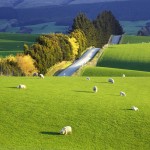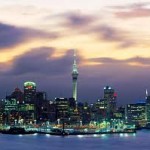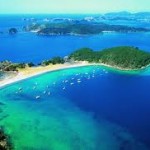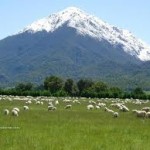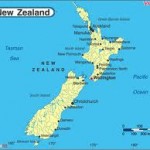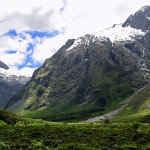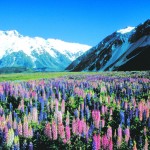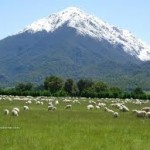New Zealand
New Zealand, a wealthy Pacific nation, is dominated by two cultural groups: New Zealanders of European descent, and the minority Maori, whose Polynesian ancestors arrived on the islands around 1,000 years ago.
Agriculture is the economic mainstay, but manufacturing and tourism are important and there is a world-class film industry.
New Zealand has diversified its export markets and has developed strong trade links with Australia, the US, and Japan. In April 2008 it became the first Western country to sign a free trade deal with China.
At a glance

- Politics: John Key led the National Party to victory in elections in 2008 and 2011
- Economy: The country officially went into recession in September 2008, for the first time in ten years
- International: New Zealand troops have taken part in regional peacekeeping efforts and have been deployed in Afghanistan
British sovereignty was established under the 1840 Treaty of Waitangi – a pact between Maori chiefs and the British government over land rights.
The treaty gave rise to land claims which culminated in the “New Zealand Wars”, a series of skirmishes between colonial forces and Maori in the North Island.
The government awarded money and land in settlements during the 1990s, but the land issue remains controversial.
In 1984 the government embarked on a dramatic and controversial economic reform programme, which lifted controls on wages, prices and interest rates and removed agricultural subsidies.

The landscape is diverse, and sometimes spectacular. This has fuelled tourism; visitors are drawn to the glacier-carved mountains, lakes, beaches and thermal springs. Because of the islands’ geographical isolation, much of the flora and fauna is unique to the country.
New Zealand plays an active role in Pacific affairs. It has constitutional ties with the Pacific territories of Niue, the Cook Islands and Tokelau.
Its troops served in East Timor when violence broke out in the territory in 1999 and were part of a multinational force intended to restore order to the Solomon Islands in 2003. Further afield, New Zealand forces have backed peacekeeping and development efforts in Afghanistan.
But its anti-nuclear stance – including a ban on nuclear-powered or nuclear-armed vessels from its waters – put it at odds with the US in the 1980s.
A significant amount of New Zealand’s electricity is generated by hydropower sources and the country has a range of renewable energy sources at its disposal.
Migration patterns have changed, with most incomers coming from Asia and Pacific island states, rather than from the UK and Australia. Officials estimate that Asians will make up 13% of the population by 2021 from about 9% in 2009.
New Zealand Facts

- Full name: New Zealand
- Population: 4.3 million (UN, 2010)
- Capital: Wellington
- Largest city: Auckland
- Area: 270,534 sq km (104,454 sq miles)
- Major languages: English, Maori
- Major religion: Christianity
- Life expectancy: 79 years (men), 83 years (women) (UN)
- Monetary unit: 1 New Zealand dollar ($NZ) = 100 cents
- Main exports: Wool, food and dairy products, wood and paper products
- GNI per capita: US $29,050 (World Bank, 2010)
- Internet domain: .nz
- International dialling code: +64
New Zealand Leaders
Head of state: Queen Elizabeth II, represented by a governor-general
Prime minister: John Key

John Key led the centre-right National Party to victory in the November 2008 general election and again in the November 2011 elections.
His party’s 2008 victory ended nine years of Labour-led government.
The National Party fell short of a parliamentary majority in both the 2008 and 2011 elections and was compelled to form a coalition with other parties.
Born in 1961 and brought up in relative poverty by his Austrian-Jewish immigrant mother after the early death of his father, Mr Key became a currency trader and has acquired a substantial personal fortune.
He rose to be head of foreign exchange at Merrill Lynch in Singapore, and served as a member of the Foreign Exchange Committee of the New York Federal Reserve Bank in 1999-2001.
National Party president John Slater encouraged him to enter politics in 2001, and Mr Key was elected to parliament the following year. He was appointed opposition finance spokesman in 2004, and became party leader in 2006 after Don Brash resigned over allegations of election-funding irregularities.
Since taking over the party, Mr Key has positioned it more on the centre ground. His first speech as leader pledged a future government to measures to prevent the creation of an “underclass”, and he has said that reducing greenhouse gas emissions by 50% in the next 50 years will be a priority.
New Zealand has a single-chamber parliament, the House of Representatives, which is elected for a three-year term. Coalition governments have been the norm since proportional representation replaced the “first past the post” electoral system in 1993.
16 July 2012 Last updated at 11:04 ET
New Zealand Media
 Government-funded Maori TV aims to revitalise Maori language, culture
Government-funded Maori TV aims to revitalise Maori language, cultureBroadcasters enjoy one of the world’s most liberal media arenas.
The broadcasting sector was deregulated in 1988, when the government allowed competition to the state-owned Television New Zealand (TVNZ). Privately-owned TV3 is TVNZ’s main competitor.
Satellite platform SKY TV is the leading pay TV provider. Freeview carries free-to-air digital terrestrial and satellite TV.
The New Zealand Herald newspaper has the biggest circulation.
Some 3.6 million New Zealanders – more than 80% of the population – were online by December 2011 (InternetWorldStats).
Country profiles compiled by BBC Monitoring

